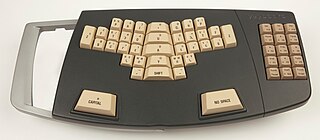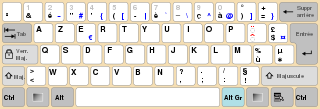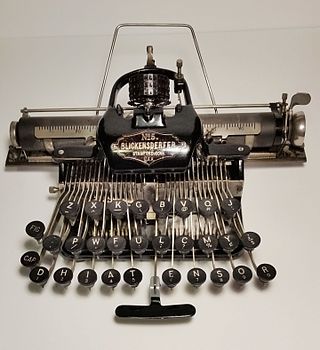Related Research Articles

A keyset or chorded keyboard is a computer input device that allows the user to enter characters or commands formed by pressing several keys together, like playing a "chord" on a piano. The large number of combinations available from a small number of keys allows text or commands to be entered with one hand, leaving the other hand free. A secondary advantage is that it can be built into a device that is too small to contain a normal-sized keyboard.

QWERTY is a keyboard layout for Latin-script alphabets. The name comes from the order of the first six keys on the top letter row of the keyboard. The QWERTY design is based on a layout included in the Sholes and Glidden typewriter sold via E. Remington and Sons from 1874. QWERTY became popular with the success of the Remington No. 2 of 1878, and remains in ubiquitous use.

Velotype is the trademark for a type of keyboard for typing text known as a syllabic chord keyboard, an invention of the Dutchmen Nico Berkelmans and Marius den Outer.

The QWERTZ or QWERTZU keyboard is a typewriter and keyboard layout widely used in Central and Southeast Europe. The name comes from the first six letters at the top left of the keyboard:.

AZERTY is a specific layout for the characters of the Latin alphabet on typewriter keys and computer keyboards. The layout takes its name from the first six letters to appear on the first row of alphabetical keys; that is,. Similar to the QWERTZ layout, it is modelled on the English QWERTY layout. It is used in France and Belgium, although each of these countries has its own national variation on the layout. Luxembourg and Switzerland use the Swiss QWERTZ keyboard. Most residents of Quebec, the mainly French-speaking province of Canada, use a QWERTY keyboard that has been adapted to the French language such as the Multilingual Standard keyboard CAN/CSA Z243.200-92 which is stipulated by the government of Quebec and the Government of Canada.
Touch typing is a style of typing. Although the phrase refers to typing without using the sense of sight to find the keys—specifically, a touch typist will know their location on the keyboard through muscle memory—the term is often used to refer to a specific form of touch typing that involves placing the eight fingers in a horizontal row along the middle of the keyboard and having them reach for specific other keys. Both two-handed touch typing and one-handed touch typing are possible.

Caps Lock⇪ Caps Lock is a button on a computer keyboard that causes all letters of bicameral scripts to be generated in capital letters. It is a toggle key: each press reverses the previous action. Some keyboards also implement a light to give visual feedback about whether it is on or off. Exactly what Caps Lock does depends on the keyboard hardware, the operating system, the device driver, and the keyboard layout. Usually, the effect is limited to letter keys. Letters of non-bicameral scripts and non-letter characters are generated normally.

Typing is the process of writing or inputting text by pressing keys on a typewriter, computer keyboard, mobile phone, or calculator. It can be distinguished from other means of text input, such as handwriting and speech recognition. Text can be in the form of letters, numbers and other symbols. The world's first typist was Lillian Sholes from Wisconsin in the United States, the daughter of Christopher Sholes, who invented the first practical typewriter.

The Blickensderfer typewriter was invented by George Canfield Blickensderfer (1850–1917) and patented on April 12, 1892. Blickensderfer was a nephew of John Celivergos Zachos, the inventor of the stenotype. Two models, Model 1 and Model 5, were unveiled to the public at the 1893 World's Columbian Exposition in Chicago. The Model 5 was a stripped-down version of the bigger, more complex Model 1. These machines were intended to compete with larger Remington, Hammond and Yost typewriters, and were the first truly portable, full-keyboard typewriters. The design also enabled the typist to see the typed work, at a time when most typewriters were understrike machines that concealed the writing. When Blickensderfer unveiled his small Model 5, its compactness and novel features attracted huge crowds and many orders.
The PLUM keyboard is a keyboard layout which differs from the traditional QWERTY keyboard in both physical key layout and letter arrangement. Unlike most keyboards, the PLUM keyboard organizes keys in a square grid, as opposed to the staggered rows of a typewriter. Though the Plum Keyboard is currently off-line, it is still being promoted.
PCD Maltron Ltd, trading as Maltron, is a manufacturer of ergonomic special-needs keyboards. It was founded by South African-born inventor Lillian Malt and manufacturer Stephen Hobday. Maltron specialises in making keyboards for the prevention and etiological treatment of repetitive strain injury.

An ergonomic keyboard is a computer keyboard designed with ergonomic considerations to minimize muscle strain, fatigue, and other problems.

A Hebrew keyboard comes in two different keyboard layouts. Most Hebrew keyboards are bilingual, with Latin characters, usually in a US Qwerty layout. Trilingual keyboard options also exist, with the third script being Arabic or Russian, due to the sizable Arabic- and Russian-speaking populations in Israel.

Dvorak is a keyboard layout for English patented in 1936 by August Dvorak and his brother-in-law, William Dealey, as a faster and more ergonomic alternative to the QWERTY layout. Dvorak proponents claim that it requires less finger motion and as a result reduces errors, increases typing speed, reduces repetitive strain injuries, or is simply more comfortable than QWERTY.

A keyboard layout is any specific physical, visual, or functional arrangement of the keys, legends, or key-meaning associations (respectively) of a computer keyboard, mobile phone, or other computer-controlled typographic keyboard.

The Neo layout is an optimized German keyboard layout developed in 2004 by the Neo Users Group, supporting nearly all Latin-based alphabets, including the International Phonetic Alphabet, the Vietnamese language, and some Cyrillic alphabets.

MessagEase is an input method and virtual keyboard for touchscreen devices. It relies on a new entry system designed by Saied B. Nesbat, formatted as a 3x3 matrix keypad where users may press or swipe up, down, left, right, or diagonally to access all keys and symbols. It is a keyboard that was designed for devices like cell phones, mimicking the early cell phones' limited number of 12 keys.

Colemak is a keyboard layout for Latin-script alphabets, designed to make typing more efficient and comfortable than QWERTY by placing the most frequently used letters of the English language on the home row while keeping many common keyboard shortcuts the same as in QWERTY. Created on 1 January 2006, it is named after its inventor, Shai Coleman.
There are a number of methods to input Esperanto letters and text on a computer, e.g. when using a word processor or email. Input methods depend on a computer's operating system. Specifically the characters ĵ, ĝ, ĉ, ĥ, ŭ, ŝ can be problematic.
Barbara Clay Henley Blackburn was an American clerical worker recognized for her claimed fast typing speed using the Dvorak keyboard layout.
References
- ↑ "One-Handed Touch-Typing on a QWERTY Keyboard". 1996.
- ↑ "Mirrorboard: A one-handed keyboard layout for the lazy". August 14, 2007.
- ↑ "Learn and Teach Typing at TypingTraining.com". typingtraining.com.